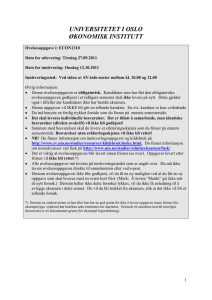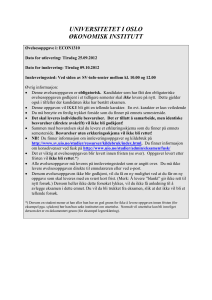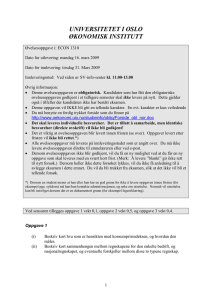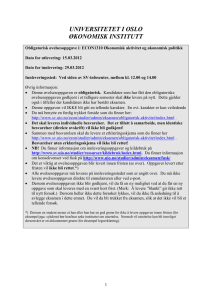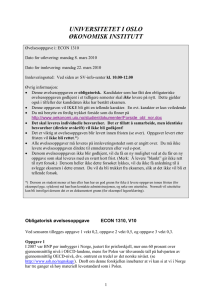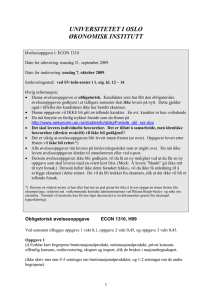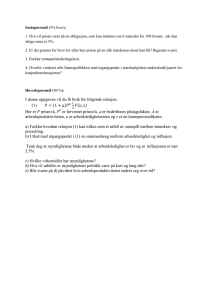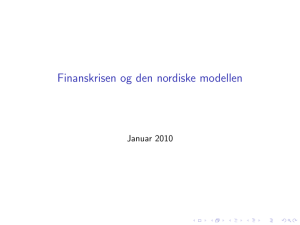UNIVERSITETET I OSLO ØKONOMISK INSTITUTT
advertisement
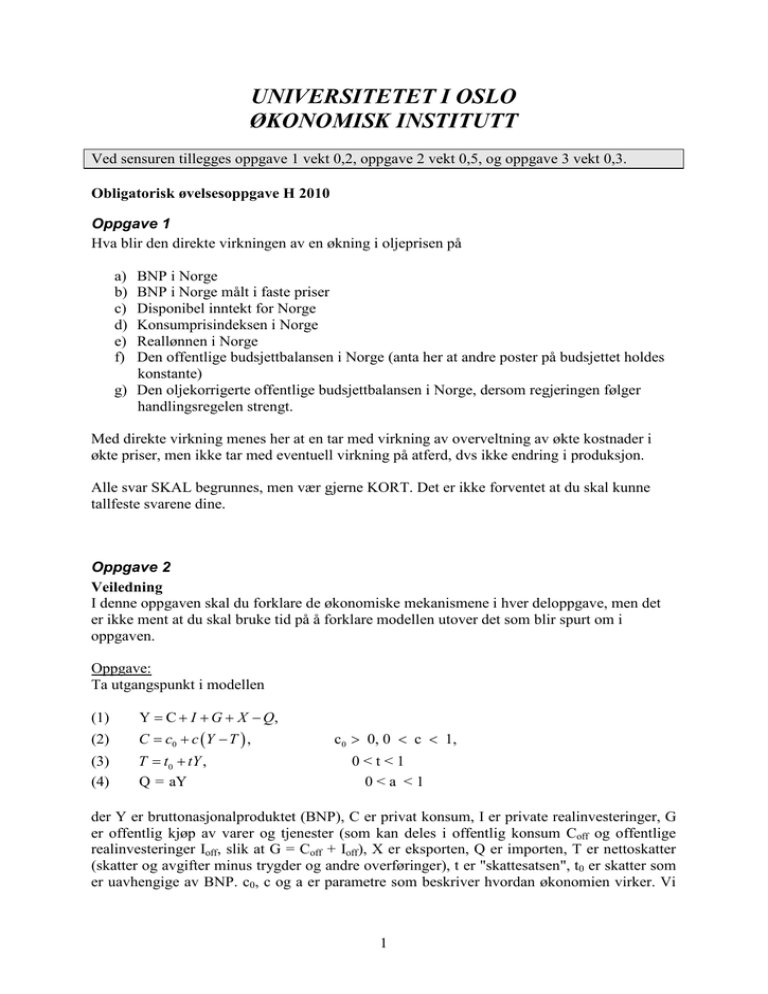
UNIVERSITETET I OSLO ØKONOMISK INSTITUTT Ved sensuren tillegges oppgave 1 vekt 0,2, oppgave 2 vekt 0,5, og oppgave 3 vekt 0,3. Obligatorisk øvelsesoppgave H 2010 Oppgave 1 Hva blir den direkte virkningen av en økning i oljeprisen på a) b) c) d) e) f) BNP i Norge BNP i Norge målt i faste priser Disponibel inntekt for Norge Konsumprisindeksen i Norge Reallønnen i Norge Den offentlige budsjettbalansen i Norge (anta her at andre poster på budsjettet holdes konstante) g) Den oljekorrigerte offentlige budsjettbalansen i Norge, dersom regjeringen følger handlingsregelen strengt. Med direkte virkning menes her at en tar med virkning av overveltning av økte kostnader i økte priser, men ikke tar med eventuell virkning på atferd, dvs ikke endring i produksjon. Alle svar SKAL begrunnes, men vær gjerne KORT. Det er ikke forventet at du skal kunne tallfeste svarene dine. Oppgave 2 Veiledning I denne oppgaven skal du forklare de økonomiske mekanismene i hver deloppgave, men det er ikke ment at du skal bruke tid på å forklare modellen utover det som blir spurt om i oppgaven. Oppgave: Ta utgangspunkt i modellen (1) Y = C + I + G + X − Q, (2) C =c0 + c (Y − T ) , (3) (4) T= t0 + tY , Q = aY c0 > 0, 0 < c < 1, 0<t<1 0<a <1 der Y er bruttonasjonalproduktet (BNP), C er privat konsum, I er private realinvesteringer, G er offentlig kjøp av varer og tjenester (som kan deles i offentlig konsum Coff og offentlige realinvesteringer Ioff, slik at G = Coff + Ioff), X er eksporten, Q er importen, T er nettoskatter (skatter og avgifter minus trygder og andre overføringer), t er "skattesatsen", t0 er skatter som er uavhengige av BNP. c0, c og a er parametre som beskriver hvordan økonomien virker. Vi 1 antar at disse parametrene har kjente verdier. Myndighetenes virkemidler er G, t0 og t. De endogene variablene er Y, C, T og Q. Modellen kan løses for Y, noe som gir (5) = Y (i) (ii) (iii) (iv) (v) 1 (c0 − ct0 + I + G + X ) 1 − c(1 − t ) + a Hva blir virkningen på BNP og den offentlige budsjettbalansen av en reduksjon i private investeringer, ΔI < 0? Anta at myndighetene ønsker å bruke skattesystemet for å forhindre at BNP endres. Hva kan myndighetene i så fall gjøre? Hva ville i så fall skje med den offentlige budsjettbalansen? Anta at den offentlige gjelden er så høy at myndighetene velger å bruke finanspolitikken til å forhindre at budsjettbalansen svekkes. Vis hvordan dette kan gjøres ved å bruke skattesystemet. Drøft verbalt om det ville vært bedre om myndighetene stabiliserte BNP ved å bruke offentlige kjøp av varer og tjenester enn ved å bruke skattesystemet. I spørsmål (iii) – finnes det en måte i modellen over som myndighetene kunne sørge for at både BNP og den offentlige budsjettbalansen ble stabilisert? Drøft kort hvordan en slik politikk ville virke i praksis. Drøft kort om endring i skattesystemet er et effekt virkemiddel for å stabilisere BNP ved en reduksjon i private investeringer, dersom husholdningene er fremoverskuende. Oppgave 3 Veiledning: I denne oppgaven skal du ikke bruke en matematisk modell, men forklare med ord hvilke effekter som kan virke i økonomien ved det som spørres om i oppgaven. Oppgave: Forklar forskjellen på arbeidsledighet og likevektsledighet. Anta at landet Norvegia er i en stabil situasjon der arbeidsledigheten er lik likevektsledigheten, og lønns- og prisveksten er stabil. Så skjer det en endring i lønnsfastsettelsen, slik at likevektsledigheten stiger. Nevn kort noen eksempler på hva som kan ha skjedd med lønnsfastsettelsen. Drøft hva som vil skje med lønns- og prisveksten, BNP og arbeidsledigheten, på kort sikt. Hva vil skje med BNP og arbeidsledigheten på lang sikt. ENGLISH VERSION Problem 1 What is the direct effect of an increase in the price of oil on a) b) c) d) GDP in Norway GDP in Norway in constant prices The disposable income for Norway The consumer price index in Norway 2 e) The real wage in Norway f) The public budget balance in Norway (assume that other components on the budget are unchanged) g) The non-oil public budget balance in Norway, if the goverment follows the fiscal rule (handlingsregelen) in a stringent way. Direct effect means that you should include the effect of an increase in costs that are shifted over in higher prices, but not any effect on behaviour, ie. no change in output. Give a BRIEF justification for all the answers. You are not expected to provide any numbers in your answers. Problem 2 Instruction In this problem you are supposed to explain the economic mechanisms for each question, but you are not supposed to spend time on explanations of the model apart from what you are asked about in the problem. Problem Consider the following model (1) (2) (3) (4) Y=C+I+G+X-Q C = c0 + c(Y - T) T = t0 + tY Q = aY c0 > 0, 0 <c < 1 0<t <1 0<a <1 where Y is gross domestic product (GDP), C is private consumption, I is private investments, G is government purchases of goods and services (which may be decomposed in public consumption Coff and public investments Ioff, where G = Coff + Ioff), X is exports, Q is imports, t is the “tax rate”, t0 is taxes that are independent of GDP, and T is net taxes (taxes minus benefits and transfers). c0, c and a are parameters describing the economy. The policy measures of the authorities are G, t0 and t. The endogenous variables are Y, C, T and Q. The model can be solved for Y, which yields (5) = Y (i) (ii) (iii) 1 (c0 − ct0 + I + G + X ) 1 − c(1 − t ) + a What is the effect on GDP and public budget balance of a decrease in private investments, ΔI < 0? Suppose that the political authorities want to use the tax systemt so as to prevent that the GDP changes. In that case, what could the authorities do? What would happen with the public budget balance? Suppose that public debt is so high that the political authorities chooses to use the fiscal policy to prevent that the public budget balance deteriorates. Show how this could be done by use of the tax system. Discuss verbally whether it be have been 3 (iv) (v) better if the authorities had stabilized GDP by use of the public purchases instead of the tax system. Under question (iii) – is there a way the government could have ensured that both GDP and the public budget balance were stabilized? Discuss briefly how a policy like this would work in practice. Discuss briefly whether a change in the tax system is an effective measure to stabilize GDP when private investments fall, if households are forward-looking. Problem 3 Instruction: In this problem you are not supposed to use a mathematical model. Rather, you are supposed to explain verbally, possibly also graphically, which effects that may work in the economy in the issue asked about in the exercise. Problem: Explain the difference between unemployment and equilibrium unemployment. Assume that the country Norvegia is in a stable situation where the rate of unemployment is equal to the equilibrium rate of unemployment, and the wage and price growth are stable. Then, a change takes place in the wage setting, leading to an increase in the equilibrium rate of unemployment. Mention briefly a few examples of what could have happened to the wage setting. Discuss what will happen with the wage and price growth, GDP, and the rate of unemployment, in the short run. What will happen with GDP and unemployment in the long run? 4
